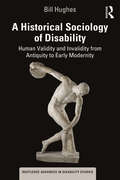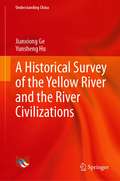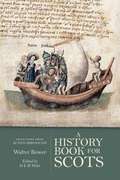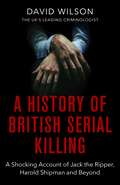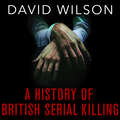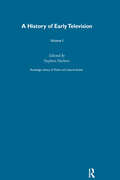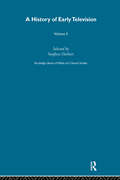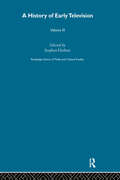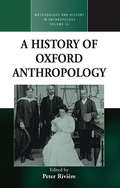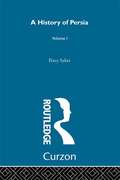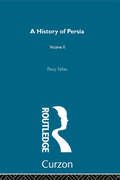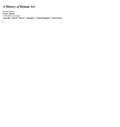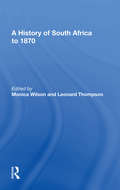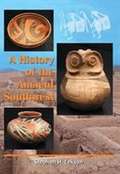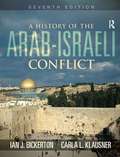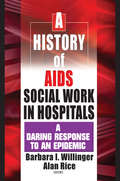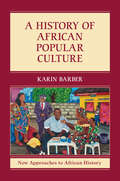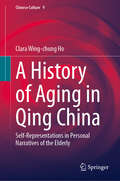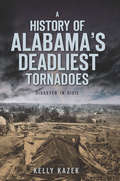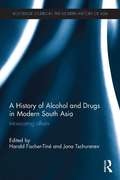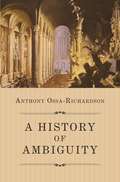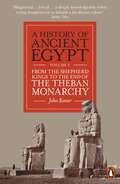- Table View
- List View
A Historical Sociology of Disability: Human Validity and Invalidity from Antiquity to Early Modernity (Routledge Advances in Disability Studies)
by Bill HughesCovering the period from Antiquity to Early Modernity, A Historical Sociology of Disability argues that disabled people have been treated in Western society as good to mistreat and – with the rise of Christianity – good to be good to. It examines the place and role of disabled people in the moral economy of the successive cultures that have constituted ‘Western civilisation’. This book is the story of disability as it is imagined and re-imagined through the cultural lens of ableism. It is a story of invalidation; of the material habituations of culture and moral sentiment that paint pictures of disability as ‘what not to be’. The author examines the forces of moral regulation that fall violently in behind the dehumanising, ontological fait accompli of disability invalidation, and explores the ways in which the normate community conceived of, narrated and acted in relation to disability. A Historical Sociology of Disability will be of interest to all scholars, students and activists working in the field of Disability Studies, as well as sociology, education, philosophy, theology and history. It will appeal to anyone who is interested in the past, present and future of the ‘last civil rights movement’.
A Historical Survey of the Yellow River and the River Civilizations (Understanding China)
by Jianxiong Ge Yunsheng HuThis book explores the relationship between rivers and ethics in China, with a particular focus on the health of the Yellow River and China’s sustainable development. Though the book falls into the category of East Asian History, it is an interdisciplinary academic work that addresses not only history, but also culture, human geography and physical geography.It traces the changes in the Yellow River over time and examines the origin and developmental course of Chinese civilization, which has always been closely intertwined with the Yellow River. It also draws comparisons between the Yellow River and the Yangtze, Nile, Tigris, Euphrates and Indus rivers to provide insights into how they have contributed to civilizations. At the same time, it discusses the lessons learned from people’s taming the Yellow River.Most significantly, the book explores the relationship between humans and the environment from an ethical standpoint, making it an urgent reminder of the crucial role that human activities play in environmental issues concerning the Yellow River so as to achieve a sustainable development for China’s “mother river.” The intended audience includes academic readers researching East Asian and Chinese history & culture, geography, human geography, historical geography, the environment, river civilizations, etc., as well as history and geography lovers and members of the general public who are interested in the Yellow River and the civilization that has evolved around it.
A Historiography of the Modern Social Sciences
by Roger E. Backhouse Philippe FontaineA Historiography of the Modern Social Sciences includes essays on the ways in which the histories of psychology, anthropology, sociology, economics, history and political science have been written since the Second World War. Bringing together chapters written by the leading historians of each discipline, the book establishes significant parallels and contrasts and makes the case for a comparative interdisciplinary historiography. This comparative approach helps explain historiographical developments on the basis of factors specific to individual disciplines and the social, political, and intellectual developments that go beyond individual disciplines. All historians, including historians of the different social sciences, encounter literatures with which they are not familiar. This book will provide a broader understanding of the different ways in which the history of the social sciences, and by extension intellectual history, is written.
A History Book for Scots: Selections from the Scotichronicon
by Walter BowerRiveting selections from a 15-century account of Scottish history, one of Scotland&’s national treasures. Writing on a small island in the Firth of Forth in the 1440s, Walter Bower set out to tell the whole story of the Scottish nation in a single huge book, the Scotichronicon— &“a history book for Scots.&” It begins with the mythical voyage of Scota, the Pharaoh&’s daughter, from Egypt with the Stone of Destiny. The land that her sons discovered in the Western Ocean was named after her: Scotland. It then describes the turbulent events that followed, among them the wars of the Scots and the Picts (begun by a quarrel over a dog); the poisoning of King Fergus by his wife; Macbeth&’s usurpation and uneasy reign; the good deeds of Margaret, queen and saint; Bruce&’s murder of the Red Comyn; the founding of Scotland&’s first university at St. Andrews; the &“Burnt Candlemas;&” and the endless troubles between Scotland and England. Weaving in and out of the events of Bower&’s factual history are other subjects that fascinated him: harrowing visions of hell and purgatory, extraordinary miracles; the exploits of knights and beggars, merchants and monks; the ravages of flood and fire; the terrors of the plague; and the answers to such puzzling questions as what makes a good king, and why Englishmen have tails. This monumental work, in which the original Latin text appears side by side with a translation in modern English, was completed in 1998. It includes an introduction and notes that guide the reader through the complexities of Bower&’s history and its background.
A History Of British Serial Killing: The Shocking Account of Jack the Ripper, Harold Shipman and Beyond
by David WilsonBE THE FIRST TO READ DAVID WILSON'S NEW TRUE CRIME BOOK "A PLOT TO KILL" BY PRE-ORDERING NOW Expanded and updated, this is the definitive history of British serial killing 1888-2020 - by the UK's leading criminologist, David WilsonIn this fascinating and informative book, Professor David Wilson tells the stories of Britain's serial killers from Jack the Ripper to the extraordinary Suffolk Murders case. David Wilson has worked as a Prison Governor and as a profiler, and has been described as the UK's leading expert on serial killers. His work has led him to meet several of the UK's deadliest killers, and build up fascinating insights into what makes a serial killer - and who they are most likely to target. A vivid narrative history and a call for prison and social reform, Professor Wilson's new book is a powerful and gripping investigation of Britain's serial murderers.
A History Of British Serial Killing: The Shocking Account of Jack the Ripper, Harold Shipman and Beyond (The Books of Babel)
by David WilsonBE THE FIRST TO READ DAVID WILSON'S NEW TRUE CRIME BOOK "A PLOT TO KILL" BY PRE-ORDERING NOW Expanded and updated, this is the definitive history of British serial killing 1888-2020 - by the UK's leading criminologist, David WilsonIn this fascinating and informative book, Professor David Wilson tells the stories of Britain's serial killers from Jack the Ripper to the extraordinary Suffolk Murders case. David Wilson has worked as a Prison Governor and as a profiler, and has been described as the UK's leading expert on serial killers. His work has led him to meet several of the UK's deadliest killers, and build up fascinating insights into what makes a serial killer - and who they are most likely to target. A vivid narrative history and a call for prison and social reform, Professor Wilson's new book is a powerful and gripping investigation of Britain's serial murderers.
A History Of Early Television Vol 1
by Stephen HerbertIn the 21st Century, broadcast television is an established part of the lives of many millions of people all over the world, bringing information and entertainment directly into our homes. The pieces in this volume date from 1879 to 1934 and consist of a selection of books, articles and news items relating to the first developmental period of television, before it became the ubiquitous medium that we know today. The selection is English language material only.
A History Of Early Television Vol 2
by Stephen HerbertIn the 21st Century, broadcast television is an established part of the lives of many millions of people all over the world, bringing information and entertainment directly into our homes. This three volume collection provides source materials for those with a new interest in the history of early television, and is a valuable resource for researchers requiring access to facsimiles of original texts.The set consists of two important 1920s-1930s books relating to television, and a collection of short articles covering the social, aesthetic, and technical aspects of the medium. Items range from 1870s prophecies, experiments and cartoons, to 1930s accounts of the first public broadcasting systems in Britain, Germany, and the USA. The pieces are from newspapers, specialist journals of the period, and popular magazines. Technical articles included are chosen for their accessibility to non-specialists with limited technical knowledge. The selection comments on the progress of television in many parts of the world.The set includes a general introduction by the editor, which places each item in context and provides a comprehensive account of the medium through 1940.The second volume starts with another selection from Television magazine and also includes selected chapters from the Book of Practical Television.
A History Of Early Television Vol 3
by Stephen HerbertIn the 21st Century, broadcast television is an established part of the lives of many millions of people all over the world, bringing information and entertainment directly into our homes. This three volume collection provides source materials for those with a new interest in the history of early television, and is a valuable resource for researchers requiring access to facsimiles of original texts.The set consists of two important 1920s-1930s books relating to television, and a collection of short articles covering the social, aesthetic, and technical aspects of the medium. Items range from 1870s prophecies, experiments and cartoons, to 1930s accounts of the first public broadcasting systems in Britain, Germany, and the USA. The pieces are from newspapers, specialist journals of the period, and popular magazines. Technical articles included are chosen for their accessibility to non-specialists with limited technical knowledge. The selection comments on the progress of television in many parts of the world.The set includes a general introduction by the editor, which places each item in context and provides a comprehensive account of the medium through 1940. This volume consists of pieces from the New York Times, Popular Mechanics and selected chapters from Television - A Struggle for Power and We Present Television.
A History Of Oxford Anthropology
by Peter RiviereInformative as well as entertaining, this volume offers many interesting facets of the first hundred years of anthropology at Oxford University.
A History Of Persia (Volume 1)
by Sir Percy SykesThis is a facsimile of a classic history first published by Macmillan in 1915 and issued in two further editions by Routledge and Kegan Paul. Sir Percy Sykes was an explorer, consul, soldier and a spy who lived and travelled in Persia over a period of twenty-five years. This two-volume collection provides a comprehensive history of Persia from Alexander the Great, through British, French and Russian colonialism, to the early twentieth century oil industry. With a new introduction by Sykes' biographer, Antony Wynn, this comprehensive history provides essential background reading to students and academics of Persia.
A History Of Persia (Volume 2)
by Sir Percy SykesThis is a facsimile of a classic history first published by Macmillan in 1915 and issued in two further editions by Routledge and Kegan Paul. Sir Percy Sykes was an explorer, consul, soldier and a spy who lived and travelled in Persia over a period of twenty-five years. This two-volume collection provides a comprehensive history of Persia from Alexander the Great, through British, French and Russian colonialism, to the early twentieth century oil industry. With a new introduction by Sykes' biographer, Antony Wynn, this comprehensive history provides essential background reading to students and academics of Persia.
A History Of Roman Art (Mindtap Course List Ser.)
by Fred S. KleinerA HISTORY OF ROMAN ART, 2nd Edition, surveys the art of Rome and its empire from the time of Romulus to the death of Constantine presented in its historical, political, and social context, with coverage of Etruscan and Greek art in Italy before the rise of Rome and of Christian art and architecture during the Late Empire. Each of the 21 chapters combines a discussion of general issues and individual monuments with a series of boxed essays on architectural terminology; materials and techniques; religion and mythology; the cultural context of works of art; the role of patrons in determining the character of Roman monuments; and the problems that ancient artists and architects faced and how they solved them.
A History Of South Africa To 1870
by Monica WilsonThis book is aimed towards advancing an understanding of the South African past essential to an appreciation of the South African promise and problems. It presents a survey of the archaeological data, and describes the hunting, herding, and cultivating peoples, and the dominant colonial society.
A History Of The Ancient Southwest
by Stephen LeksonAccording to archaeologist Stephen H. Lekson, much of what we think we know about the Southwest has been compressed into conventions and classifications and orthodoxies. This book challenges and reconfigures these accepted notions by telling two parallel stories, one about the development, personalities, and institutions of Southwestern archaeology and the other about interpretations of what actually happened in the ancient past. <P><P>While many works would have us believe that nothing much ever happened in the ancient Southwest, this book argues that the region experienced rises and falls, kings and commoners, war and peace, triumphs and failures. <P><P>In this view, Chaco Canyon was a geopolitical reaction to the "Colonial Period" Hohokam expansion and the Hohokam "Classic Period" was the product of refugee Chacoan nobles, chased off the Colorado Plateau by angry farmers. <P><P>Far to the south, Casas Grandes was a failed attempt to create a Mesoamerican state, and modern Pueblo people--with societies so different from those at Chaco and Casas Grandes--deliberately rejected these monumental, hierarchical episodes of their past.
A History Of The Arab-Israeli Conflict (Seventh Edition)
by Ian J. BickertonConcise and comprehensive, A History of the Arab-Israeli Conflict presents balanced, impartial, and well-illustrated coverage of the history of the Arab-Israeli conflict. The authors identify and examine the issues and themes that have characterized and defined the conflict over the past century tying in a twenty-first century perspective. The seventh edition exposes readers to recent events in the Middle East. Altering relations between Israel and neighboring states, political and religious uncertainty as a result of the Arab Spring and the increased scrutiny of Iran's nuclear program are explored in this updated edition.
A History of AIDS Social Work in Hospitals: A Daring Response to an Epidemic
by Barbara I Willinger Alan RiceExplore the in-hospital evolution of social work with HIV/AIDS patients!A History of AIDS Social Work in Hospitals: A Daring Response to an Epidemic presents first-hand historical perspectives from frontline hospital social workers who cared for HIV/AIDS patients during the epidemic&’s beginning in the early 1980s. Contributors recount personal and clinical experiences with patients, families, significant others, bureaucracies, and systems during a time of fear, challenge, and extreme caution. Their experiences illustrate the transformation of social work as the development of new programs and treatments increased the lifespan of HIV/AIDS patients.A History of AIDS Social Work in Hospitals portrays the nature of human suffering and teaches how clients deal with adversity and overcome devastating obstacles. At the same time this book, which, while nonfiction, reads like a novel, opens a window into the world of social work providers working with an illness once considered taboo (and now referred to as simply "chronic"). A History of AIDS Social Work in Hospitals provides you with an easy-to-understand medical overview of adult and pediatric infectious diseases that often accompany HIV/AIDS and examines: the evolution of social work with hospitalized patients during the first twenty years of the pandemic the important roles of social workers in New York, San Francisco, Philadelphia, and South Carolina challenges that resulted from improved medications and longer life expectancy the status of current HIV/AIDS care programs the development of HIV/AIDS case management in emergency room settings the benefits of developing custody planning programs for HIV-infected families the challenges of working with perinatally infected adolescentsWith case studies and thoughtful analysis of the history of city, state, and national case management responses to the AIDS crisis, A History of AIDS Social Work in Hospitals is a valuable book for educators, students, historians, beginning mental health practitioners, social workers, case managers, substance abuse counselors, and anyone interested in stories of human courage. Make it part of your collection today!
A History of African Motherhood
by Rhiannon StephensThis history of African motherhood over the longue durée demonstrates that it was, ideologically and practically, central to social, economic, cultural and political life. The book explores how people in the North Nyanzan societies of Uganda used an ideology of motherhood to shape their communities. More than biology, motherhood created essential social and political connections that cut across patrilineal and cultural-linguistic divides. The importance of motherhood as an ideology and a social institution meant that in chiefdoms and kingdoms queen mothers were powerful officials who legitimated the power of kings. This was the case in Buganda, the many kingdoms of Busoga, and the polities of Bugwere. By taking a long-term perspective from c. 700 to 1900 CE and using an interdisciplinary approach - drawing on historical linguistics, comparative ethnography, and oral traditions and literature, as well as archival sources - this book shows the durability, mutability and complexity of ideologies of motherhood in this region.
A History of African Popular Culture (New Approaches to African History #11)
by Karin BarberPopular culture in Africa is the product of everyday life: the unofficial, the non-canonical. And it is the dynamism of this culture that makes Africa what it is. In this book, Karin Barber offers a journey through the history of music, theatre, fiction, song, dance, poetry, and film from the seventeenth century to the present day. From satires created by those living in West African coastal towns in the era of the slave trade, to the poetry and fiction of townships and mine compounds in South Africa, and from today's East African streets where Swahili hip hop artists gather to the juggernaut of the Nollywood film industry, this book weaves together a wealth of sites and scenes of cultural production. In doing so, it provides an ideal text for students and researchers seeking to learn more about the diversity, specificity and vibrancy of popular cultural forms in African history.
A History of Aging in Qing China: Self-Representations in Personal Narratives of the Elderly (Chinese Culture #9)
by Clara Wing-chung HoThis book examines the history of aging and old age during the Qing dynasty, a pivotal period marked by rapid population growth that resulted in the largest elderly population in imperial China. Drawing on previously overlooked first-person accounts from the extensive collections authored by Qing men and women, it offers an overview of the self-curated collective aging journeys of several hundreds of elders. By centering the voices of individuals reflecting on their aging experiences, this book delves into the personal narratives from both genders, rediscovering their aging journeys, revealing their subjectively constructed emotional landscapes, and giving a voice to the elderly individuals of the past. The chapters closely analyze how the elderly in Qing China articulated their aging process, channeling their joys, challenges, and frustrations in later life. History is not the monopoly of a single gender, class, race, or age group; without representations of the elderly, history remains incomplete. This book seeks to restore the elderly to the historical narrative and invites further discussion on Chinese historical gerontology as an emerging subfield. In addition to appealing to general readers interested in contemporary demographic issues from a historical perspective, this book will engage students and researchers of history, historical gerontology, aging studies, gender studies, cultural studies, sociology, psychology, and Asian studies.
A History of Alabama's Deadliest Tornadoes: Disaster in Dixie
by Kelly KazekJourney just west of America's infamous Tornado Alley to Alabama, home to some of the deadliest tornadoes of the past century. These twisters remain etched in the collective memory of the people, from the 1908 Dixie Tornado, regarded as one of the most brutal tornadoes in U.S. history, to the 1998 Birmingham Tornado, the most expensive twister in Alabama's history. Discover how the 1932 Deep South Tornadoes resulted in 268 fatalities and millions of dollars in damage, and read the terrifying account of the 1977 Smithfield Tornadoes, which rocked this Birmingham suburb with as many as six twisters in a one-hour span. Join local journalist Kelly Kazek as she shares the tales of these natural disasters and the hardy Alabamians who endured them.
A History of Alcohol and Drugs in Modern South Asia: Intoxicating Affairs (Routledge Studies in the Modern History of Asia)
by Harald Fischer-Tiné Jana TschurenevAt the beginning of the 21st century, alcoholism, transnational drug trafficking and drug addiction constitute major problems in various South Asian countries. The production, circulation and consumption of intoxicating substances created (and responded to) social upheavals in the region and had widespread economic, political and cultural repercussions on an international level. This book looks at the cultural, social, and economic history of intoxicants in South Asia, and analyses the role that alcohol and drugs have played in the region. The book explores the linkages between changing meanings of intoxicating substances, the making of and contestations over colonial and national regimes of regulation, economics, and practices and experiences of consumption. It shows the development of current meanings of intoxicants in South Asia – in terms of politics, cultural norms and identity formation – and the way in which the history of drugs and alcohol is enmeshed in the history of modern empires and nation states — even in a country in which a staunch teetotaller and active anti-drug crusader like Mohandas Gandhi is presented as the ‘father of the nation’. Primarily a historical analysis, the book also includes perspectives from Modern Indology and Cultural Anthropology and situates developments in South Asia in wider imperial and global contexts. It is of interest to scholars working on the social and cultural history of alcohol and drugs, South Asian Studies and Global History.
A History of Ambiguity
by Anthony Ossa-RichardsonEver since it was first published in 1930, William Empson’s Seven Types of Ambiguity has been perceived as a milestone in literary criticism—far from being an impediment to communication, ambiguity now seemed an index of poetic richness and expressive power. Little, however, has been written on the broader trajectory of Western thought about ambiguity before Empson; as a result, the nature of his innovation has been poorly understood.A History of Ambiguity remedies this omission. Starting with classical grammar and rhetoric, and moving on to moral theology, law, biblical exegesis, German philosophy, and literary criticism, Anthony Ossa-Richardson explores the many ways in which readers and theorists posited, denied, conceptualised, and argued over the existence of multiple meanings in texts between antiquity and the twentieth century. This process took on a variety of interconnected forms, from the Renaissance delight in the ‘elegance’ of ambiguities in Horace, through the extraordinary Catholic claim that Scripture could contain multiple literal—and not just allegorical—senses, to the theory of dramatic irony developed in the nineteenth century, a theory intertwined with discoveries of the double meanings in Greek tragedy. Such narratives are not merely of antiquarian interest: rather, they provide an insight into the foundations of modern criticism, revealing deep resonances between acts of interpretation in disparate eras and contexts. A History of Ambiguity lays bare the long tradition of efforts to liberate language, and even a poet’s intention, from the strictures of a single meaning.
A History of Ancient Egypt, Volume 3: From the Shepherd Kings to the End of the Theban Monarchy
by John RomerThe final chapter in the definitive, three-volume history of the world's first known stateArchaeologist John Romer has spent a lifetime chronicling the history of Ancient Egypt, and here he tells the epic story of an era dominated by titans of the popular imagination: the radical iconoclast Akhenaten, the boy-king Tutankhamun and the all-conquering Ramesses II. But 'heroes' do not forge history by themselves. This was also a time of international trade, cultural exchange and sophisticated art, even in the face of violent change.Alongside his visionary new history of this, the most famous period in the long history of Ancient Egypt, Romer turns a critical eye on Egyptology itself. Paying close attention to the evidence, he corrects prevailing narratives which cast the New Kingdom as an imperial state power in the European mould. Instead, he reveals - through broken artefacts in ruined workshops, or preserved letters between a tomb-builder and his son - a culture more beautiful and beguiling than we could have imagined.Romer carefully reconstructs the real story of the New Kingdom as evidenced in the archaeological record, and the result - the final volume of a life long project - secures his status as Ancient Egypt's finest chronicler.
